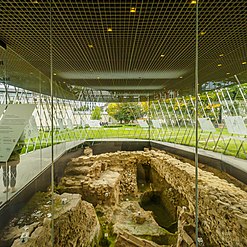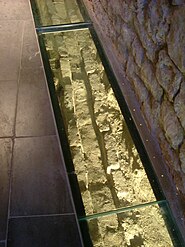Archaeological windows in Aachen
The archaeological windows in Aachen are showcases or viewing windows in the public space of Aachen's old town or in buildings that are at least temporarily publicly accessible or visible, in which historically significant archaeological finds from Aachen's city history can be viewed at the place where they were found.
General overview
In order to be able to present archaeologically interesting structures that cannot be lifted out of the ground without being destroyed or whose recovery means a great deal of effort, several archaeological windows were set up in Aachen . These are showcases or viewing windows that protect the objects from the weather, but allow the viewer visual access. The majority of the objects exhibited in these windows have been placed under monument protection as ground monuments . The former cover plates of the Pau Canal embedded in the pavement of the racecourse have no cover or other protection.
Descriptions of each window
Archaeological windows of the city of Aachen
There are urban archaeological windows in the cathedral , at the Aachen town hall , in the Elisengarten behind the Elisenbrunnen , the Klappergasse , the racetrack and at the Templergraben. The showcases were financed by various sponsors and donated to the city of Aachen.
- Aachen Cathedral ( location ) The octagon of the Palatine Chapel was built on the ruins of Roman buildings, probably a thermal bath and an attached hostel. The archaeological window in the cathedral shows parts of the foundation of the Palatine Chapel, Roman underfloor heating ( hypocaust ) and a Roman sewer that were part of the bathing facility and are now part of the foundation of the Aachen Cathedral. Another window in the cathedral is behind the right entrance pillar of the octagon, where you can see part of the original flooring that was exposed during the renovation of recent years.
- Aachen City Hall ( location ) On the left side of the city hall right next to the entrance to the Ratskeller, sections of the Carolingian foundation walls of the city hall, which were made around the year 800, can be seen in a window. The reuse of older stones such as a Roman tombstone can also be seen. The remaining mortar is colored reddish by brick dust. The brick powder was added to the mortar to ensure better stability.
- Elisengarten ( location ) The area around Aachen has been populated since the Neolithic. In a 160 m² archaeological showcase in the Elisengarten, over 5000 years of city history are presented by preparing several excavation stages, from Stone Age and Celtic finds to those from Roman times , the Carolingian times , the Middle Ages and modern details.
- Klappergasse ( location ) The window in Klappergasse on the corner of Jakobstrasse shows parts of a medieval canal made from bluestone . He led the water of the Pau to a grain mill , the brother mill, which belonged to the community of the canons of the Marienstift . The canal is again built on a wall that belongs to a construction that was probably built in the 9th / 10th Century was built. No further information is available about this structure.
- Racetrack ( location ) In the racetrack , plates embedded in the footpath illustrate the historical course of the Pau, which had been canalized since the Middle Ages.
- Templergraben ( location ) Emperor Friedrich I , known as Barbarossa, initiated the construction of a city wall in 1171, which is known today as the Barbarossa Wall . The construction and execution were state-of-the-art and the defense systems in Aachen were among the most modern of the time. Parts of the foundations can be seen at the Templergraben opposite the RWTH Aachen Central Library .
Privately owned archaeological windows
There are other archaeological windows in private buildings. However, they are at least temporarily accessible to the public or can be viewed from the outside.
- Buchkremerstraße 1–7 ( location ) Parts of the old Bücheltherme are on display in a shop window of the Mayersche bookstore next to the main entrance. It is an 18-ton, two-meter-high, 2.60-meter-long and 1.20-meter-wide part of a Roman apse of the former thermal baths. The rough brickwork made of greywacke and lime mortar is clearly visible from the front .
- Büchel 10 ( location ) In the so-called Büchelpalais , under a glass cover, there is an exposed medieval water pipe, the age and purpose of which is still speculated. It may have been used to supply water to a wool kitchen that operated in this house between the 14th and 17th centuries. After the house was used as a grain hall from around 1685, which caused rather dry conditions, the water pipe must obviously have been shut down. It was only rediscovered after renovation work in 2006 and can now be viewed in the local business premises during opening hours.
- Markt 46 ( location ) In the basement of a restaurant in the Markt 46 building, the remains of an old Roman fortified tower can be seen under a glass plate, which belonged to a fortification that surrounded today's market hill in an almost circular manner and was equipped with 12 to 15 towers. In some areas the wall is more than four meters thick and of extremely hard substance. In connection with other finds in the market area and the surrounding area, it can be assumed that the ground level was five meters lower two thousand years ago and that the market hill was provided with a Roman fort . The facility can be viewed during the opening times of the restaurant.
- Ursulinerstraße 7/9 ( location ) The remains of a Roman wall that once delimited the most important square in the center of Aquae Granni can be seen through a glass plate sunk into the ground on the first floor of the commercial building (a drugstore when the window was built) . The associated column architecture was set up as a copy at Am Hof .
Picture gallery
- Selection of archaeological windows in Aachen
Web links
Individual evidence
- ↑ List of archaeological windows in Aachen on archäologie-aachen.de, accessed on October 18, 2015.
- ^ Archaeological Window in Aachen Cathedral , accessed on October 18, 2015.
- ^ Archaeological window at the town hall , accessed on October 18, 2015.
- ^ Archaeological Pavilion in the Elisengarten , accessed on October 18, 2015.
- ^ Archaeological Window Klappergasse , accessed on October 18, 2015.
- ↑ Pau Canal in the racecourse , accessed on October 18, 2015.
- ^ Barbarossamauer am Templergraben , accessed on October 18, 2015.
- ↑ Archaeological showcase Elisenbrunnen, accessed on October 18, 2015
- ↑ Werner Czempas: Mayersche Buchhandlung: The Roman Colossus has found home , in Aachener Nachrichten of September 3, 2010
- ↑ Büchelpalais
- ↑ Robert Esser: 1700 year old treasures slumber under the market , in: Aachener Nachrichten of March 20, 2019
- ^ Archaeological Window Ursulinerstraße 7/9 , accessed on October 18, 2015.








